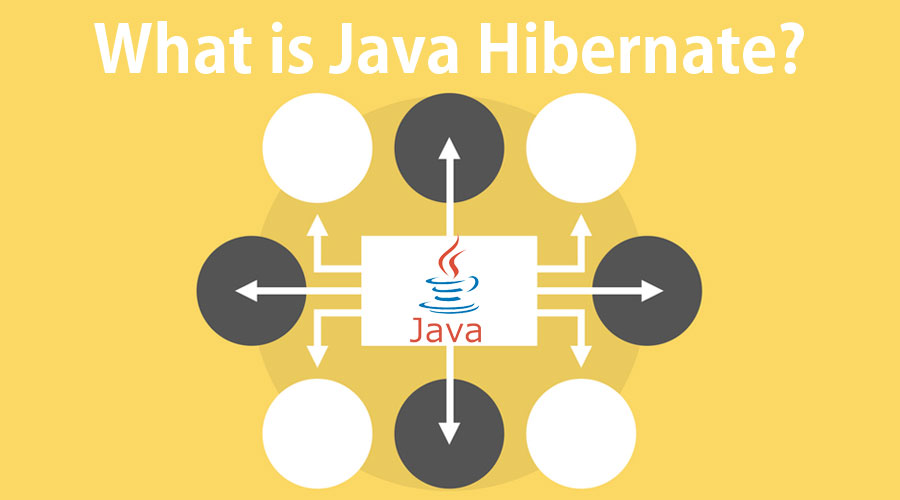Updated June 3, 2023

Definition of Java Hibernate
Java Hibernate is an object-relational mapping tool(ORM) allowing the mapping of object-oriented models to relational databases for web applications by providing a framework. Mapping of entities in a Java class to tables created in a database and mapping from Java data types to SQL data types is one of the primary functions of Hibernate. You can also inquire about or retrieve data using Hibernate. It relieves the developer from manually handling the database.
What is Java Hibernate?
Hibernate is the Object-Relational Mapping (ORM) framework in Java created by Gavin King in 2001. It simplifies the interaction of a database and the Java application being developed. It is an ORM tool that is powerful and lightweight. Another important thing is that this is a high-performance open-source tool. Hibernate implements Java Persistence API specifications and is a powerful object-relational persistence and query service for applications developed in Java.
Understanding Java Hibernate
Java objects and database server interacts with each other via Hibernate. Hibernate will work to persist the Java objects depending upon the correct O/R patterns and recognition mechanisms. The architecture of Hibernate is layered such that the user does not need to know the underlying APIs to operate. With the help of the database and configuration data, Hibernate can provide persistence services and objects to the application. The architecture of Hibernate consists of objects like a session factory, transaction factory, persistent object, etc.
Hibernate framework uses many objects such as session factory, session, transaction, etc., along with existing Java API such as JDBC (Java Database Connectivity), JTA (Java Transaction API), and JNDI (Java Naming Directory Interface).
There are four layers in Hibernate architecture. These are listed below:
- Layer 1 – Java Application Layer
- Layer 2 – Hibernate Framework Layer
- Layer 3 – Backend API Layer
- Layer 4 – Database Layer
Why do we Need Hibernate in Java?
To retrieve data from the database, repeatedly writing the same lines of code in your application, again and again, can be tiring and irritating. Also, switching from one database to another, implementing oops with JDBC, and creating associations between database tables require lots of effort and rework without using the Hibernate framework. As already told, Java Hibernate is an ORM tool that helps ease all these issues faced while using JDBC for database connectivity.
When compared to JDBC, Hibernate will connect itself with the database. To execute the queries, Hibernate uses Hibernate Query Language or HQL. Once the queries have been executed, Hibernate will then perform the mapping of the results to their respective application layer. This mapping results in objects totally based on the properties mentioned in the configuration XML file of Hibernate. A session does not only help an application in creating a connection with the database but also works toward saving and fetching the persistent object in Hibernate.
Using Session Factory (an interface), one can create an instance of a session and use this instance just because there should only be one session factory for every database. For example, if an application uses two databases: MySQL and Oracle, one session factory should be maintained for MySQL, and one session factory should be maintained for Oracle. You can’t maintain two separate session factories for Oracle or MySQL alone.
Advantages of Java Hibernate
Object Relational Mapping, or ORM, is an answer to the problem of easily mapping the Object Domain Model to relational persistence collection. Hibernate is a free and open-sourced object-relational mapping library for Java specifically built to map objects to any Relational Database Management System. It is also helpful in implementing object-oriented programming concepts in a relational database.
Let us have a look at some of the main advantages we get by implementing ORM-
- High Yielding: Implementing an application with JDBC presents a significant challenge: spending time developing, tuning, and maintaining the relevant JDBC code. The answer to this is ORM. Using ORM decreases the time it takes to implement an application exponentially, eliminating the need to examine the code and mapping mechanism. A robust, ready, and trusted ORM engine efficiently manages the database.
- Well-Structured: ORM has a practical design pattern implemented and tested well. It does not require redoing an already completed task which is also tried, tested, and used again, thus saving time.
Advantages of Hibernate
Hibernate implements the architectural design pattern of ORM just as similar to other implementations. It has got many pros and cons. Now we’ll list down the advantages of using the Hibernate.
They are as under :
- Database Independent: At the backend, Hibernate is independent of the database’s engine.
- Built-In Connection Pool Implementation: Hibernate integrates with the most reliable connection pool implementation, that is, C3P0, automatically.
- Layered Architecture: Hibernate, as a layered architecture, doesn’t obligate us to use everything it provides. We use those features that we may think are light enough for the project.
- JPA Provider: Java Persistence API, that is, JPA, is considered a specification. There are a lot of implementations that are available for JPA, such as EclipseLink, OpenJPA, and many more. It is a standard ORM solution and, in addition, encompasses JPA capability. Therefore, the usage of hibernating helps us in leveraging all of the capabilities of ORM as well as JPA in JPA-specific projects.
Conclusion
Hibernate is an ORM tool that maps database structures with Java objects dynamically at runtime. Using Hibernate, a persistent framework, allows the developers to focus on just business logic code writing despite writing accurately, as well as a good persistence layer that consists of writing the SQL Queries, connection management, and JDBC Code.
Recommended Article
This has been a guide to What is Java Hibernate. Here we discussed the concepts, definition, and understanding with the advantage of Java Hibernate. You can also go through our other suggested articles to learn more –


